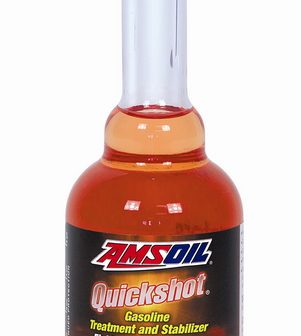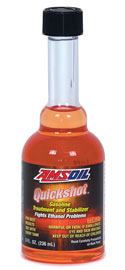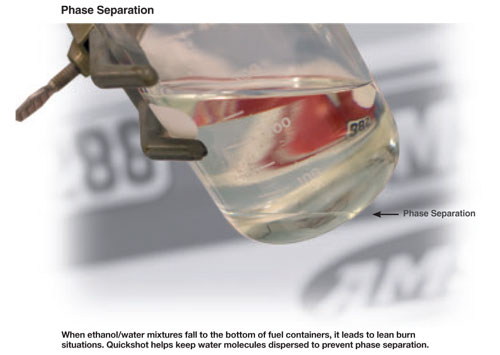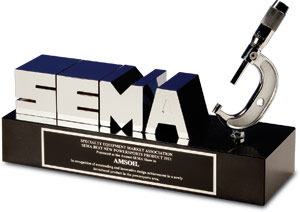
Quickshot® Restores Peak Performance in Small Engines and Powersports Equipment Premium fuel additive formulated to thoroughly clean and restore peak performance in small engine and powersports equipment fuel systems.
Amsoil’s Quickshot quickly restores powersports and small engine lost performance
While the Quickshot stabilizes fuel and fights ethanol problems, let’s talk about it’s main purpose. To decarbonize and clean fuel intake systems. Small engines with fuel issues such as carbon, varnish build-up. sticky valves, erratic idle causing the engine to speed up then slow down (triggering the governor), etc. can all be corrected with Quickshot. Any motorcycle, outboard, chainsaw, snowblower, or anything that runs at a constant speed you will drastically love the effect from Quickshot.
One customer repeated what I have seen which adding it to his mower it seemed to now run 100 to 200 more RPMs now.
Pete Maina, Muskie Expert and Professional Angler says he won’t guide in a customers boat without a bottle of Quickshot in hand. 2-stroke outboards suffer from a lack of fuel maintenance which eventually causes a host of issues. Quickshot makes it easy.
Another AMSOIL product which you you don’t have to read any further as it’s the seat of the pants performance which says it all. It’s one of our best return traffic products we sell. Comments from customers tell it all. Noticeable improvements to throttle response and top end.
Small Engines and Motorcycles now have relief from degraded fuel and Ethanol Problems
Restores Peak Performance in Small Engines, Powersports Equipment and 2-Cycle engines.
Degraded fuel presents a major maintenance issue in small engines and powersports equipment. It can form varnish, gum and insoluble debris that clog carburetors, fuel injectors and fuel filters. Carbon buildup can form on the tops of pistons that leads to pre-ignition, rough idling and poor throttle response. Fuel-related problems are only expected to intensify in the coming years as the ethanol content in pump gasoline continues to increase.
Package Size Includes
8-oz. Bottle (Treats 6 to 12 gallons of gasoline)
8-oz. Bottles (case of 6)
Quart bottles (Treats 24-48 gallons of gasoline)
Call 800-579-0580 for competitive current price.
Or use the online preferred customer portal if you choose to order online.
Printable Product Data Sheet for AMSOIL Quickshot SE
Download PDFProduct DatasheetGet more info from AMSOIL and a free Catalog!
AMSOIL Quickshot (Product Code AQS) is a premium fuel additive formulated to thoroughly clean and restore peak performance in small engine and powersports equipment fuel systems. It also stabilizes fuel between uses and during short-term storage. Its revolutionary technology focuses on three major fuel-related issues plaguing these applications: ethanol, water and dirty pump gas.
Ethanol Issues
Ethanol in fuel has a tendency to absorb water and separate from the gasoline (a process known as phase separation), sinking to the bottom of the gas tank where it quickly degrades and creates gum, varnish and other insoluble debris that can plug fuel-flow passages and negatively affect engine performance. When this ethanol/water mixture is pulled into the engine, it creates a lean-burn situation that increases combustion chamber temperatures and can lead to engine damage. AMSOIL Quickshot is designed to keep water dispersed throughout the fuel tank, moving it out as a normal part of operation and decreasing the chance of ethanol separating from the gasoline.
Quickshot was tested in fuel containing 10 percent ethanol. Controlled plugging of injectors showed a 70 percent flow improvement, while oxidation stability improved 44 percent over untreated fuel.
Disperses Water
Water finds its way into gas tanks through condensation in tanks open to the atmosphere, gas pumps and other environmental conditions, and if left untreated, will cause starting, performance and corrosion problems. By keeping water dispersed in tiny molecules and safely moving it out of the tank through the combustion chamber, Quickshot helps maintain engine performance and protects against damaging corrosion.
Dirty Gasoline
Dirty gasoline causes fuel-system gumming and varnish, as well as piston and combustion chamber deposits. Although all gasoline sold in the U.S. is formulated with a lowest additive concentration (LAC) level of detergent additives, these detergent levels are not enough to prevent deposits from building up on critical fuel system components. Quickshot contains unique chemistry that quickly detaches and carries away deposits and buildups in fuel systems, injectors and carburetors, while also cleaning hard-to-remove deposits on piston tops, spark plugs and other combustion chamber parts.
Applications
Quickshot is recommended for use in all two- and four-stroke gasoline-powered engines, including motorcycles, snowmobiles, boats, personal watercraft, ATVs, edgers, tillers, mowers, snowblowers, chainsaws, generators and farm and construction equipment. However, AMSOIL P.i. Performance Improver is the superior choice for passenger vehicle applications.
Recommendations
Quickshot is designed for an initial clean-up dose of 8 oz. per 6 gallons of gasoline, followed by 8 oz. per 12 gallons thereafter.
Buy & Check Price& Bottle Sizes
I have sold quite a bit of this product, lots of return sales including one friend and local customer asking “What the hell is this stuff?” impressed with the added mileage and throttle response in his Harley. One local customer noticed an additional 20 miles in a tank of gas – proving the degradation of your fuel system with out proper fuel maintenance.
The side of the bottle has the mix rate clearly with well marked graduations so it’s easy to use in all sizes of gasoline containers.
Want a clean engine , you’ll have a clean engine .
great for the small engines
Lawn equipment fuel system
When you need a cleanup
Great product
Exceptional Product
Keeps the fuel system clean
I use it, and sell it to my customers.
Nothing Better
Archived article:
E15 fuel has been approved for sale. Be Prepared!
Its impact will be felt differently by motorists and powersports enthusiasts.
As I write this month’s Tech Talk, the U.S. nationwide average price for a gallon of gasoline is $3.85. On May 8, the Energy Information Administration (EIA) released a revised forecast for gas prices during the summer driving season (April through September) that predicts the average price will drop to $3.79. Thats good news for all of us, whether filling up for the daily commute or planning a longer road trip. Regardless of what vehicle you drive, its likely that maximizing fuel economy and extending engine life are high priorities. In fact, a 2011 survey by the Consumer Reports National Research Center found the age of the average car driven by respondents has increased to eight years, with 23 percent of motorists surveyed driving cars from the 1990s. And for those planning on purchasing a new or newer model, 62 percent expected their next vehicles to have better fuel economy than their previous models.
Motorists are demanding more from newer vehicles and also want their current vehicles to last longer, but new government mandates might make achieving higher efficiencies more difficult.
In April 2012, the Environmental Protection Agency (EPA) approved the sale of E15 (15 percent ethanol and 85 percent gasoline) for cars and trucks manufactured in 2001 or later. This extended by six years a 2010 waiver permitting the use of motor gasoline blends containing up to 15 percent ethanol in 2007 and newer vehicles. All other gas-powered engines, such as those on boats, snowmobiles, lawn mowers, motorcycles and off-road vehicles, are prohibited from using E15. This means that the current E10 (10 percent ethanol/90 percent gasoline) blended fuel, sold at more than 90 percent of service stations nationwide, remains the de facto choice for owners of model year 2000 and older vehicles and other gas-powered engines. The exception to this being flex-fuel vehicles compatible with E85 (85 percent ethanol/ 15 percent gasoline).
Automakers have resisted the new E15 ruling, arguing that their vehicles new and old aren’t designed to accommodate gasoline containing 15 percent ethanol. Service station owners have concerns about potential liability issues arising from consumers using the wrong ethanol blend and are worried about the costs of retrofitting gas pumps or installing new ones to make E15 available.
While the future of E15 is uncertain, ethanol-blended fuels are here to stay. Ethanol has been used for decades as a gasoline additive because it burns cleaner than gasoline. The downside to ethanol is its fuel economy and performance. Ethanol produces less energy than gasoline. According to the EIA, A gallon of ethanol has only two-thirds the energy of a gallon of conventional gasoline, and the number of miles traveled by a given vehicle per gallon of fuel is directly proportional to the energy contained in the fuel. In addition, studies have shown fuel systems containing plastic or rubber components can be damaged by ethanol exposure. There are also problems at the molecular level. Ethanol and gasoline do not form chemical bonds and ethanol is highly attracted to water. Even small amounts of water entering the fuel supply can break the weak ethanol-to-water bond and separate (phase separation). This suspension falls to the bottom of the fuel tank and can increase engine temperatures and cause engine damage. Less energy per gallon and phase separation are just two of the problems inherent with ethanol-blended gasoline. Smaller engines face additional maintenance and performance issues.
Because the widely available E10 can start degrading in just 30 days, the shorter shelf life of ethanol-blended gasoline vs. pure gasoline is another potential problem for small-engine operation. With equipment such as motorcycles, ATVs, boats and other less frequently used tools like chainsaws and leaf blowers, fuel may sit in the tank for a month or much longer between starts. During this time gasoline absorbs water, which leads to fuel breakdown. As gasoline degrades, gums and varnish can clog carburetors, fuel injectors and fuel filters. The result is decreased starting performance and drivability issues. Most drivers fuel their passenger vehicles more frequently than every 30 days, so gasoline breakdown issues are less common in autos and trucks. Additionally, many newer vehicles have computer sensors that make adjustments for high ethanol content, but the majority of small engines lack such technology. Fortunately for powersports enthusiasts, there are solutions to this long-term problem.
Quickshot® is designed to keep water dispersed and helps combat problems associated with ethanol-blended fuel. It also cleans deposit build-up in fuel systems and combustion chamber components. This means better performance and reduced impact from ethanol-blended fuels. We all value our free time; engines need to start on command when we get a sliver of time to get out and go.
| Amsoil’s PowerSports Manager talks about Quick Shot |
Customers who bought Amsoil’s Small Engine Maintenance Products also bought the following products:
AMSOIL Small Engine 4-Stroke 10W30/SAE. 30 Synthetic Oil
AMSOIL MP Metal Protector and moisture displacement spray.
15w-50 small engine oil for Vanguard motors





